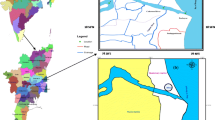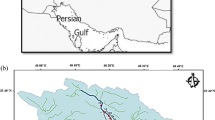Abstract
The accumulation of heavy metals in stream sediment depends on various influencing factors. Sediments are aggregation of number of species along with organic debris. Accretion of heavy metals on sediment is the outcome of absorption by fine-grain inorganic particles of clays, adsorption of hydrous ferric and clays, and complexation with natural organic matters. These processes are regulated by different influencing factors including TOC and pH. This study reveals the spatial distribution of potentially toxic heavy metals (Cd, Hg, Pb, Co, Cu, Cr, Ni, and Zn) and assessment of contamination levels to find out the role of TOC and pH in distribution of heavy metal contamination in major industrial stream sediment in Chandrapur district, Central India. The pollution indices and multivariate statistical analysis were carried out to identify the correlation between various parameters. The concentration of anthropological derived heavy metals is higher in TOC-rich area. PCA and HCA study reveals that heavy metals are significantly correlated with TOC of the sediments, while Ni is associated with pH. Chromium shows the ambiguous behavior towards association with pH and TOC. The study also reveals that there is urgent need for assessment of Wardha River and Erai River basins because there could be hotpots for heavy metal contamination.







Similar content being viewed by others
References
Adams, R. H. Jr. (2003). Economic growth, inequality, and poverty: Findings from a new data set (English). Policy, Research working paper; no. WPS 2972. Washington, DC: World Bank Group.
Azadi, N., Mansouri, B., Spada, L., Sinkakarimi, M., Hamesadeghi, Y., & Mansouri, A. (2018). Contamination of lead (Pb) in the coastal sediments of north and south of Iran: A review study. Chemistry and Ecology, 34, 884–900.
Bilos, C., Colombo, J. C., Skorupka, C. N., & Rodriguez Presa, M. J. (2001). Sources, distribution and variability of airborne trace metals in La Plata City area, Argentina. Environmental Pollution, 111, 149–158.
Chandra, M. (2015). Environmental concerns in India: Problems and solutions. Journal of International Business and Law, 15, 1–15
Cosovic, B., Vojvodic, V., Boskovic, N., Plavsic, M., & Lee, C. (2010). Characterization of natural and synthetic humic substances (melanoidins) by chemical composition and adsorption measurements. Organic Geochemistry, 41, 200–205.
Czikkely, M., Neubauer, E., Fekete, I., Ymeri, P., & Fogarassy, C. (2018). Review of heavy metal adsorption processes by several organic matters from wastewaters. Water, 10, 1–15.
Das, S., & Ting, Y. P. (2017). Evaluation of wet digestion methods for quantification of metal content in electronic scrap material. Resources, 64, 1–16.
Duncan, A., Vries, N., & Nyarko, K. (2018). Assessment of heavy metal pollution in the sediments of the River Pra and its tributaries. Water Air and Soil Pollution, 272, 1–10.
Eke, U. I., Ndulaka, J. C., & Onuh, C. F. (2017). Environmental pollution and heavy metals. European Journal of Biotechnology and Bioscience, 5, 73–78.
Equeenuddin, S. M., Tripathy, S., Sahoo, P. K., & Panigrahi, M. K. (2013). Metal behavior in sediment associated with acid mine drainage stream: Role of pH. Journal of Geochemical Exploration, 124, 230–237.
Gaudette, H. E., Flight, W. R., Toner, L., & Folger, D. W. (1974). An inexpensive titration method for the determination of organic carbonin recent sediments. Journal of Sedimentary Petrology, 44, 249–253.
Gibbs, R. J. (1977). Transport phases of transition metals in the Amazon and Yukon Rivers. Geological Society of America Bulletin, 88, 829–843.
Hakanson, L. (1980). An ecological risk index for aquatic pollution control. A sedimentological approach. Water Research, 14, 975–1001.
Jain, C. K. (2004). Metal fractionation study on bed sediments of River Yamuna, India. Water Research, 38, 569–578.
Khan, B., Ullah, H., Khan, S., Aamir, M., Khan, A., & Khan, W. (2016). Sources and contamination of heavy metals in sediments of Kabul River: The role of organic matter in metals retention and accumulation. Soil and Sediment Contamination, 25, 891–904.
Ma, X. (2016). Assessment of heavy metals contamination in sediments from three adjacent regions of the Yellow River using metal chemical fractions and multivariate analysis techniques. Chemosphere, 144, 264–272.
Maharashtra Pollution Control Board, Mumbai. (2006). Environmental status and action plan for control of pollution at Chandrapur.
Muller, G. (1979). Index of geoaccumulation in sediments of the Rhine River. Journal of Geology, 2, 108–118.
Pande, J., & Singh, R. (2017). Heavy metals in sediments of Ganga River: Up- and downstream urban influences. Applied Water Science, 7, 1669–1678.
Patra, S., Shoo, S., Mishra, P., & Mahapatra, S. (2018). Impacts of urbanization on land use /cover changes and its probable implications on local climate and groundwater level. Journal of Urban Management, 7, 70–84.
Powar, A., Tennant, R., Jones, R., Tang, Y., Du, J., Worsley, A., & Love, J. (2018). Monitoring impacts of urbanisation and industrialisation on air quality in the anthropocene using urban pond sediments. Frontiers in Earth Science, 6, 1–18.
Sakan, S. M., Dordevic, D. S., Manojlovic, D. D., & Predrag, P. S. (2009). Assessment of heavy metal pollutants accumulation in the Tisza river sediments. Journal of Environmental Management, 90, 3382–3390.
Singhal, S. (2003). India 2025-Enviornment. Planning Commission of India.
Wang, X. (2009). New evidence for the importance of Mn oxides contributed to nitrobenzene adsorption onto the surficial sediments in Songhua River, China. Journal of Hazardous Materials, 172, 755–762.
Watson, M. E. and Brown J. R. (1998). pH and lime requirement, recommended chemical oil test procedures for the North Central Region, North Central Regional Research Publication, No. 221. Missouri Agricultural Experiment Station SB 1001.
Wen, X., & Allen, H. E. (1999). Mobilization of heavy metals from Le An River sediments. Science of the Total Environment, 227, 101–108.
Winter, J., & Dodou, D. (2016). Common factor analysis versus principal component analysis: A comparison of loadings by means of simulations. Communications in Statistics –Simulation and Computation, 45, 299–321.
Yang, B., Wen, X., & Sun, X. (2015). Irrigation depth far exceeds water uptake depth in an oasis cropland in the middle reaches of Heihe River Basin. Scientific Reports, 5, 1–12.
Yuebing, S., Qixing, Z., Xiaokui, X., & Rui, L. (2010). Spatial, sources and risk assessment of heavy metal contamination of urban soils in typical regions of Shenyang, China. Journal of Hazardous Materials, 174, 455–462.
Zhang, C. (2017). Heavy metal concentrations and speciation in riverine sediments and the risks posed in three urban belts in the Haihe Basin. Ecotoxicology and Environmental Safety, 139, 263–271.
Funding
The authors are thankful to RTM Nagpur University for the financial assistance under University Research Scheme, DST, New Delhi, for DST-FIST grant and UGC, New Delhi, for UGC-SAP program.
Author information
Authors and Affiliations
Corresponding author
Additional information
Publisher’s Note
Springer Nature remains neutral with regard to jurisdictional claims in published maps and institutional affiliations.
Rights and permissions
About this article
Cite this article
Bakshe, P., Jugade, R. Distribution, Association, and Ecological Risk Evaluation of Heavy Metals and Influencing Factors in Major Industrial Stream Sediments of Chandrapur District, Central India. Water Air Soil Pollut 232, 78 (2021). https://doi.org/10.1007/s11270-021-05040-3
Received:
Accepted:
Published:
DOI: https://doi.org/10.1007/s11270-021-05040-3




